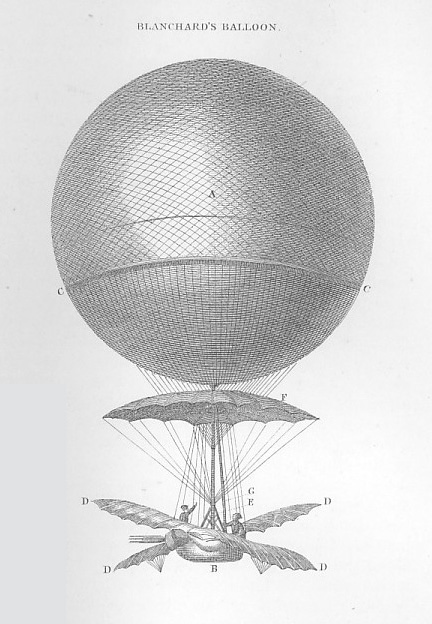1902 Encyclopedia > Aeronautics > First Ascents of Balloons in England. Andreani. Blanchard.
Aeronautics
(Part 13)
First Ascents of Balloons in England. Andreani. Blanchard.
We now return to the history of aerial navigation, and commence with an account of the first ascents of balloons in this country. Although the news of the Annonay and subsequent experiments in France rapidly spread all over Europe, and formed a topic of general discussion, still it was not till five months after the Montgolfiers had first publicly sent a balloon into the air that any aerostatic experiment was made in England. In November 1783 Count Zambeccari, an Italian, who happened to be in London, made a balloon of oil-silk, 10 feet in diameter, and weighing 11 lb. It was publicly shown for several days, and on the 25th it was three-quarters filled with hydrogen gas, and launched from the Artillery ground at one o'clock. It descended after two hours and a half near Petworth, in Sussex, 48 miles from London. This was the first balloon that ascended from English ground. On February 22, 1784, a hydrogen gas balloon, 5 feet in diameter, was let up from Sandwich, in Kent, and descended at Warneton, in French Flanders, 75 miles distance. This was the first balloon that crossed the Channel. The difficulties and dangers o aerial navigation having been surmounted by the end of the year 1783, the ascents of balloons were now multiplied in all quarters. It will therefore be sufficient to notice very briefly only the more remarkable of the succeeding ascents.
The Chevalier Paul Andreani, of Milan, constructed a fire-balloon 68 feet in diameter, and on February 25, 1784, ascended from Milan with two brothers of the name of Gerli, and remained in the air for about twenty minutes. This is usuallyregarded as the first ascent in Italy (but see Monck Mason's Aeronautica, p. 247). Andreani ascended again on March 13, with two other persons.

Balloon of Jean Pierre Blanchard
On the 2nd of March M. Jean Pierre Blanchard, who had been for some years before occupied with projects for flying, made his first voyage from Paris in a balloon 27 feet in diameter, and descended at Billancourt, near Sevres. Just as the balloon was about to ascend, a young man jumped into the car, and, drawing his sword, declared his determination to ascend with Blanchard. He was ultimately removed by force. The episode is worth noting, as it has sometimes been stated that the young man was Napoleon Bonaparte, but this is untrue; his name was Dupon de Chambon. Blanchard made subsequently, it is said, more than thirty aerial voyages, and he is one of the most celebrated of the earlier aeronauts. He also crossed the English Channel, as noticed further on.
On July 15, 1784, the Duc de Charles and the two brothers Robert ascended from St Cloud; but the neck of the balloon becoming choked up with an interior balloon filled with common air, intended to regulate the ascending and descending power, they were obliged to make a hole in the balloon, in order to allow to the escape of the gas, but they descended in safety.
Read the rest of this article:
Aeronautics - Table of Contents
|
